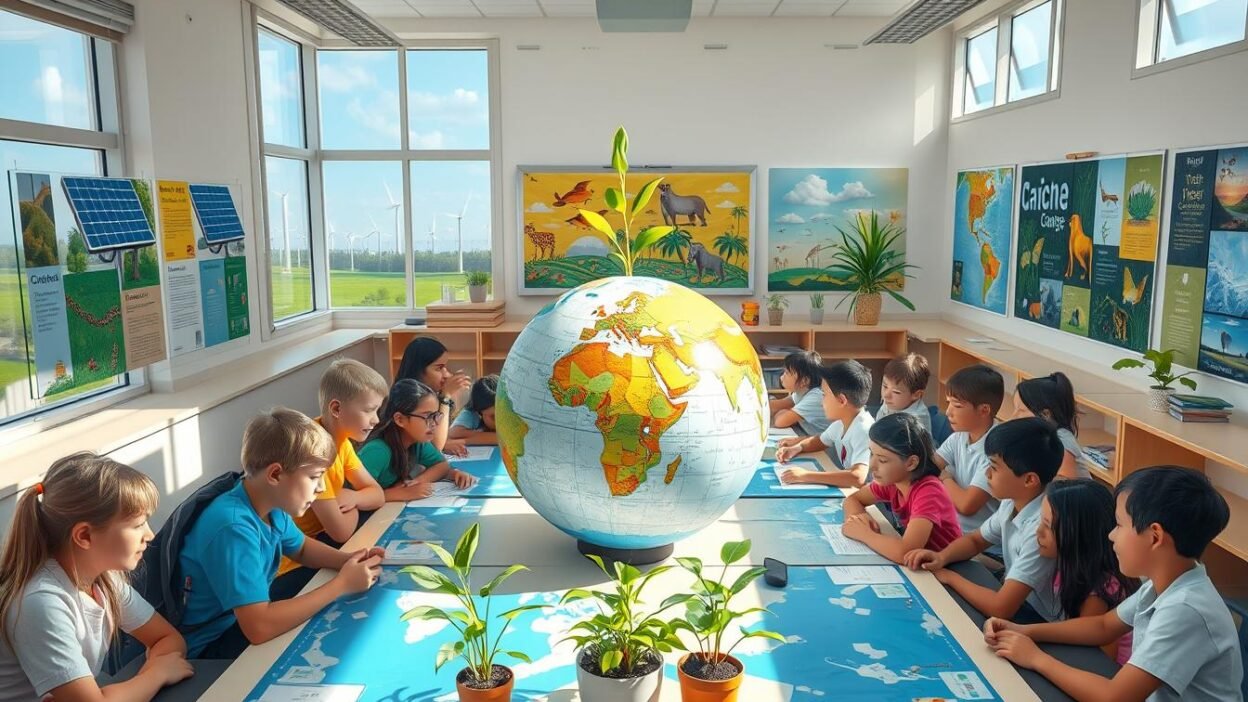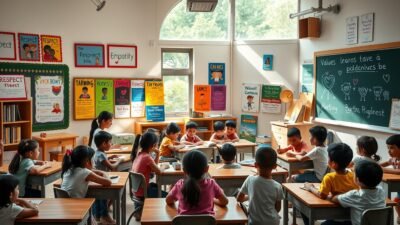Did you know that 85% of young people in India feel they have learned little to nothing about climate change in school? This startling statistic underscores the urgent need for comprehensive climate change education in our academic systems, particularly within the framework of UGC NET Paper 1.
As we face unprecedented environmental challenges, the role of educators in shaping a sustainable future has never been more critical. UGC NET Paper 1, a crucial component for aspiring teachers, offers a unique opportunity to integrate climate change education into the core of our educational framework.
Preparing for the UGC NET exam can be a daunting task, but with the right resources, candidates can navigate the process effectively. Websites like MyJRF provide a comprehensive platform for aspiring educators, offering specialized guidance for UGC NET Paper 2 preparation and essential tips for acing UGC NET Paper 1. Additionally, understanding the revised syllabus provided by UGC is crucial for a targeted study approach. For official announcements and updates, candidates should regularly visit the UGC NET NTA portal, while the UGC’s job section and the main UGC website are invaluable for post-exam opportunities and academic resources. With these tools, candidates can maximize their preparation and set themselves up for success.
By equipping future educators with the knowledge and tools to teach about climate change, we can empower the next generation to tackle environmental issues head-on. This approach not only aligns with global sustainability goals but also prepares students for the complex realities of a changing world.
Key Takeaways
- 85% of Indian youth report insufficient climate change education in schools
- UGC NET Paper 1 provides a platform to integrate climate change education
- Educators play a vital role in building a sustainable future
- Climate change education aligns with global sustainability goals
- Empowering students with knowledge leads to effective environmental action
Understanding the UGC NET Paper 1 Framework
The UGC NET exam plays a crucial role in assessing the teaching aptitude of aspiring educators. This section delves into the structure and significance of Paper 1, a key component of the UGC NET.
UGC NET Exam Format
The UGC NET consists of two papers. Paper 1 tests general aptitude and teaching skills, while Paper 2 focuses on subject-specific knowledge. Paper 1 comprises 50 multiple-choice questions, with candidates given 1 hour to complete it.
Significance of Paper 1
Paper 1 carries substantial weight in the UGC NET. It evaluates a candidate’s grasp of essential teaching concepts and their ability to apply these in educational settings. Success in Paper 1 often indicates a strong foundation for effective teaching.
Essential Educational Topics
Paper 1 covers a wide range of educational topics. These include teaching methodologies, research aptitude, and comprehension skills. The exam tests knowledge on educational systems, learning theories, and current trends in pedagogy.
- Teaching and Learning Environment
- Communication in Teaching
- Research Methodologies
- Higher Education System
- Information and Communication Technology in Education
Understanding these key areas prepares candidates for success in the UGC NET Paper 1 and lays the groundwork for effective teaching practices.
The Imperative of Climate Change Education
Climate change education stands as a crucial pillar in building a sustainable future. As global temperatures rise and extreme weather events become more frequent, the need for widespread climate change awareness grows ever more pressing.
Why Climate Change Awareness Matters
Understanding the impacts of climate change empowers individuals to make informed decisions. It shapes our daily choices, from energy consumption to transportation methods. By raising climate change awareness, we cultivate a society ready to tackle environmental challenges head-on.
Global Perspectives on Climate Change
Climate change affects different regions in unique ways. Coastal communities face rising sea levels, while inland areas grapple with droughts. These diverse global perspectives highlight the need for tailored educational approaches. By studying various climate impacts, we gain a comprehensive view of this global issue.
Integrating Climate Change into Curricula
Curriculum integration is key to effective climate education. Schools can weave climate topics into existing subjects like science, geography, and social studies. This approach helps students see the interconnections between climate change and various aspects of life.
“Education is the most powerful weapon which you can use to change the world.” – Nelson Mandela
By prioritizing climate change education, we equip future generations with the knowledge and skills needed to create a sustainable world. It’s not just about learning facts; it’s about inspiring action and fostering a deep commitment to environmental stewardship.
How UGC NET Paper 1 Aligns with Sustainability Goals
The UGC NET Paper 1 plays a key role in shaping educator preparedness for teaching sustainability. This exam assesses future teachers on their ability to integrate crucial topics like climate change into their lessons.
Education and Sustainability Connection
Education forms the backbone of sustainable development. By equipping students with knowledge about environmental issues, we empower them to make eco-friendly choices. The UGC NET Paper 1 tests educators on their grasp of these concepts, ensuring they can pass this vital information to their students.
UGC NET’s Impact on Educator Readiness
The UGC NET exam prepares educators to tackle sustainability topics in the classroom. It covers key areas such as:
- Environmental awareness
- Sustainable resource management
- Climate change mitigation strategies
By testing these subjects, the exam ensures that future teachers are well-equipped to guide students toward a sustainable future.
| UGC NET Paper 1 Focus Areas | Relevance to Sustainability Goals |
|---|---|
| Teaching Aptitude | Effective communication of sustainability concepts |
| Research Aptitude | Analyzing climate data and trends |
| Comprehension | Understanding complex environmental issues |
| Communication | Engaging students in sustainability discussions |
Through its comprehensive coverage, UGC NET Paper 1 aligns closely with global sustainability goals, fostering a new generation of environmentally conscious educators.
Pedagogical Approaches to Teaching Climate Change
Climate change education demands innovative teaching methods. Educators must engage students in meaningful ways to grasp this complex topic. Let’s explore effective strategies for climate change instruction.
Interactive Learning Techniques
Interactive learning brings climate change concepts to life. Role-playing exercises let students embody different stakeholders in climate scenarios. Group discussions encourage critical thinking about environmental issues. Hands-on experiments demonstrate greenhouse effects, fostering deeper understanding.
Incorporating Real-World Case Studies
Case studies bridge theory and practice in climate education. Examining real-world examples helps students grasp climate change impacts. They analyze local environmental challenges, propose solutions, and learn from global climate initiatives. This approach develops problem-solving skills and environmental awareness.
Use of Technology in Climate Education
Educational technology enhances climate change learning. Virtual reality simulations immerse students in changing ecosystems. Online platforms facilitate collaborative projects on sustainability. Data visualization tools help interpret complex climate models. These tech-driven methods make abstract concepts tangible.
| Teaching Method | Benefits | Examples |
|---|---|---|
| Interactive Learning | Increased engagement, deeper understanding | Climate change debates, eco-friendly design challenges |
| Case Studies | Real-world application, critical thinking | Local sustainability projects, global climate agreements |
| Educational Technology | Visual learning, data interpretation | Climate simulation games, carbon footprint calculators |
By combining these approaches, educators create dynamic learning environments. Students develop a comprehensive understanding of climate change and feel empowered to act. These methods prepare the next generation to tackle environmental challenges head-on.
The Role of Educators in Climate Change Awareness
Educators play a vital role in shaping the future by raising awareness about climate change. Their influence extends beyond the classroom, creating a ripple effect in communities and society at large.
Teacher Training and Development
Teacher training is crucial for effective climate education. Programs that focus on climate science and sustainability equip educators with the knowledge and skills to inspire students. These initiatives often include hands-on experiences and real-world examples to enhance learning.
Workshops and online courses offer opportunities for continuous professional development. They cover topics like energy conservation, biodiversity, and climate policy. This ongoing education ensures teachers stay updated on the latest climate research and teaching methods.
Empowering Students as Climate Advocates
Student empowerment is key to creating lasting change. Teachers can foster a sense of responsibility and action in their students through various strategies:
- Encourage participation in local environmental projects
- Organize school-wide sustainability initiatives
- Support student-led climate action groups
- Incorporate climate-related topics into different subjects
By engaging students in these activities, educators help develop the next generation of climate advocates. These young leaders can drive positive change in their schools, homes, and communities.
| Teacher Training Focus | Student Empowerment Activities |
|---|---|
| Climate science fundamentals | School recycling programs |
| Sustainable living practices | Energy conservation challenges |
| Climate policy and governance | Youth climate summits |
| Interdisciplinary climate education | Community awareness campaigns |
Policy Implications for Climate Education
Climate change education shapes the future of our planet. Education policies play a crucial role in preparing students to tackle environmental challenges. This section explores how national and local efforts contribute to climate awareness.
National Education Policies on Climate Change
India’s education policies are evolving to address climate change. The National Education Policy 2020 emphasizes environmental education at all levels. It aims to integrate sustainability concepts across subjects, fostering eco-conscious citizens.
- Mandatory environmental studies in schools
- Teacher training programs on climate science
- Green campus initiatives in universities
- Research funding for climate-related projects
Local Initiatives and Community Engagement
Local initiatives bring climate education to life. Schools partner with nearby organizations to create hands-on learning experiences. Community engagement helps students connect classroom knowledge to real-world issues.
Examples of successful local initiatives:
| Initiative | Description | Impact |
|---|---|---|
| School Garden Projects | Students grow organic vegetables | Promotes sustainable farming practices |
| Beach Clean-up Drives | Regular coastal area clean-ups | Raises awareness about marine pollution |
| Energy Audits | Students assess school energy use | Encourages energy conservation |
These local initiatives showcase how community engagement can enhance climate education. By combining national policies with grassroots efforts, India is paving the way for a more sustainable future.
Innovative Programs for Climate Change Education
Climate change education is evolving rapidly, with innovative education programs sprouting up worldwide. These initiatives aim to equip students with the knowledge and skills needed to tackle environmental challenges head-on.
Successful Examples from Around the World
In India, the Green Schools Program empowers students to audit their school’s environmental impact. This hands-on approach helps kids understand resource consumption and conservation. Another standout is Finland’s Climate University, which offers free online courses on climate change to anyone interested.
Collaborations Between Schools and NGOs
School-NGO collaborations are powering many successful climate education initiatives. These partnerships bring expertise and resources into classrooms, enriching learning experiences.
| NGO | Program | Impact |
|---|---|---|
| WWF-India | Nature Clubs | 1000+ schools engaged |
| Centre for Environment Education | Paryavaran Mitra | 200,000+ students reached |
| The Energy and Resources Institute | Green Olympiad | 2.5 million participants since 1999 |
These innovative programs and collaborations are transforming climate change education. By making learning interactive and relevant, they’re inspiring a new generation of environmental stewards.
Measuring the Impact of Climate Change Education
Evaluating the effectiveness of climate change education is crucial for shaping informed citizens. Schools and institutions need robust methods to gauge the success of their programs and make necessary improvements.
Assessment Tools and Metrics
Educational metrics play a vital role in measuring student understanding of climate change concepts. These tools range from traditional tests to innovative approaches:
- Pre and post-course surveys
- Project-based assessments
- Climate literacy quizzes
- Behavioral change tracking
Impact assessment goes beyond grades. It examines how students apply their knowledge in real-world scenarios and make sustainable choices in their daily lives.
Feedback Mechanisms for Continuous Improvement
Feedback mechanisms are essential for refining climate change education programs. They provide valuable insights into what works and what needs adjustment:
- Student feedback forms
- Teacher observations
- Parent input sessions
- Community engagement surveys
These feedback loops help educators tailor their teaching methods, update curriculum content, and address any gaps in student understanding. By continuously improving based on these insights, schools can ensure their climate change education remains effective and relevant.
The Future of Climate Change Education
Climate change education stands at a pivotal point. As we face growing environmental challenges, the need for effective teaching strategies becomes crucial. This section explores the evolving landscape of climate education research and the preparation of educators for future challenges.
Trends in Climate Education Research
Climate education research is shifting towards more interactive and experiential learning methods. Studies show that hands-on activities and real-world problem-solving boost student engagement and understanding. Digital tools, like climate simulations and data visualization, are becoming key components in classrooms.
A growing focus in climate education research is the integration of local contexts. This approach helps students connect global issues to their immediate surroundings, making the subject more relatable and actionable.
Preparing Educators for Tomorrow’s Challenges
Educator preparation for climate change teaching is evolving rapidly. Training programs now emphasize interdisciplinary approaches, combining science with social studies, economics, and ethics. This holistic view equips teachers to address the complex nature of climate issues.
Future challenges in climate education include:
- Keeping pace with rapidly changing climate science
- Addressing climate anxiety among students
- Developing culturally sensitive teaching materials
- Integrating technology effectively in climate lessons
| Key Area | Current Focus | Future Direction |
|---|---|---|
| Teaching Methods | Lecture-based | Interactive and project-based |
| Technology Use | Supplementary | Central to curriculum |
| Scope | Science-centric | Interdisciplinary approach |
| Student Role | Passive learners | Active problem-solvers |
As climate education evolves, educators must adapt to new teaching paradigms. Continuous professional development and collaboration with climate scientists will be key to meeting these future challenges head-on.
Student Perspectives on Climate Change Education
Students play a vital role in shaping climate change education. Their voices bring fresh insights and drive meaningful action. Schools now recognize the importance of student perspectives in creating effective climate awareness programs.
Gathering Student Input and Feedback
Collecting feedback from students helps improve climate education. Schools use surveys, focus groups, and class discussions to gather student input. This approach ensures lessons resonate with young learners and address their concerns.
A recent study found that 85% of students want more climate change content in their curricula. They seek practical knowledge on reducing carbon footprints and advocating for environmental policies.
Fostering a Culture of Climate Awareness
Creating a climate-conscious school environment goes beyond the classroom. Student-led initiatives like eco-clubs and sustainability projects boost engagement. These activities empower students to become climate advocates in their communities.
“When we involve students in climate education planning, we see a dramatic increase in participation and real-world impact,” says Dr. Priya Sharma, an environmental education expert.
Schools can foster climate awareness by:
- Organizing student-led climate action days
- Integrating sustainability into school operations
- Encouraging students to share climate knowledge with families
By valuing student perspectives and nurturing climate awareness, schools prepare future generations to tackle environmental challenges head-on.
Promoting Equity in Climate Change Education
Climate change affects everyone, but not all students have equal access to quality education about this critical issue. Educational equity is key to preparing future generations to tackle environmental challenges. This section explores ways to bridge access disparities and implement inclusive teaching practices in climate change education.
Addressing Disparities in Education Access
Access to climate change education varies widely across regions and socioeconomic groups. Rural areas often lack resources, while urban schools may struggle with overcrowding. To combat these disparities, schools can:
- Partner with local organizations to bring climate experts into classrooms
- Develop online resources for remote learning
- Create mobile climate education labs to reach underserved areas
Inclusive Teaching Practices
Inclusive teaching ensures all students can engage with climate change topics. Effective strategies include:
| Practice | Benefit |
|---|---|
| Multi-language resources | Supports non-native speakers |
| Culturally relevant examples | Increases student engagement |
| Hands-on activities | Accommodates different learning styles |
| Peer-to-peer learning | Encourages collaboration and empathy |
By addressing access disparities and employing inclusive teaching methods, educators can ensure that all students have the opportunity to learn about and contribute to solutions for climate change. This approach not only promotes educational equity but also cultivates a diverse, informed generation of environmental stewards.
Conclusion: Building a Sustainable Future Through Education
As we wrap up our exploration of climate change education, it’s clear that educators play a pivotal role in shaping a sustainable future. The UGC NET Paper 1 framework offers a solid foundation for teachers to build their knowledge and skills in this critical area.
The Collective Responsibility of Educators
Educators bear a unique responsibility to prepare future generations for the challenges of climate change. By integrating climate awareness into curricula and fostering critical thinking, teachers can empower students to become active participants in creating a more sustainable world. This collective effort is essential for addressing the global climate crisis.
Call to Action for Future Generations
The time for action is now. Future generations of educators must prioritize climate change education in their teaching practices. By doing so, they can inspire students to become environmental stewards and problem-solvers. This call to action extends beyond the classroom, urging all of us to contribute to a sustainable future through informed decisions and responsible actions.
In conclusion, the path to a sustainable future lies in education. By embracing this responsibility, educators can help shape a world where environmental consciousness and sustainable practices are the norm. Let’s work together to build a brighter, greener future for all.
FAQ
What is the significance of climate change education in UGC NET Paper 1?
Climate change education is crucial in UGC NET Paper 1 as it prepares educators to address environmental challenges and build a sustainable future. It equips teachers with the knowledge and skills to effectively integrate climate awareness into their curricula, fostering a generation of environmentally conscious citizens.
How does UGC NET Paper 1 align with sustainability goals?
UGC NET Paper 1 supports sustainability objectives by assessing educators’ knowledge of key educational topics, including those related to climate change and sustainability. It plays a vital role in preparing teachers to effectively convey these critical concepts to students, thereby contributing to broader sustainability goals.
What are some effective pedagogical approaches for teaching climate change?
Effective approaches include interactive learning techniques, incorporating real-world case studies, and utilizing educational technology. These methods enhance student engagement and understanding of complex climate issues, making the subject more accessible and relatable.
How can educators empower students to become climate advocates?
Educators can empower students by providing them with accurate information, encouraging critical thinking about climate issues, and involving them in practical sustainability projects. By fostering a sense of environmental responsibility and agency, teachers can inspire students to become active climate advocates in their communities.
What role do national education policies play in climate change education?
National education policies are crucial in shaping the framework for climate change education. They set standards for curriculum integration, allocate resources, and provide guidelines for teacher training. These policies ensure a consistent and comprehensive approach to climate education across educational institutions.
How can the impact of climate change education be measured?
The impact can be measured through various assessment tools and metrics, such as standardized tests, project-based evaluations, and long-term behavioral studies. Feedback mechanisms, including surveys and focus groups, also play a crucial role in continuously improving educational initiatives and measuring their effectiveness.
What are some current trends in climate education research?
Current trends include the integration of interdisciplinary approaches, the use of advanced technologies like virtual reality for immersive learning experiences, and the development of localized curriculum models that address specific regional climate challenges. Research is also focusing on the psychological aspects of climate education and its long-term impact on behavior change.
How can climate change education promote equity?
Climate change education can promote equity by addressing disparities in access to quality environmental education. This involves developing inclusive teaching practices, providing resources to underserved communities, and ensuring that climate education is culturally relevant and accessible to all students, regardless of their socioeconomic background.





